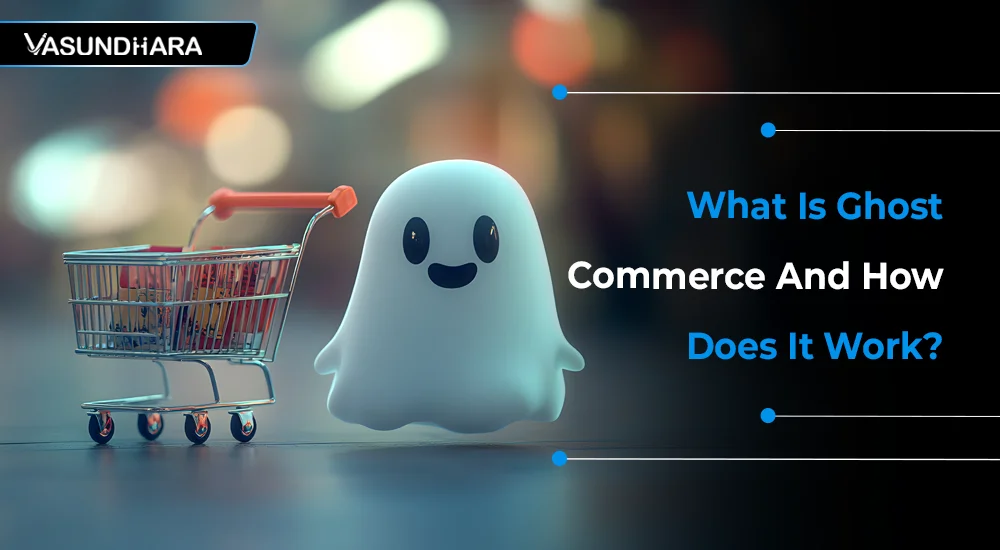What Is Ghost Commerce And How Does It Work?


- Sep 25, 2024
In today’s digital landscape, commerce continues to evolve at a breakneck pace. Businesses constantly seek innovative ways to reach customers, offer products, and generate revenue. One such modern evolution of e-commerce is "Ghost Commerce." This intriguing business model has started to gain attention, particularly among entrepreneurs and marketers looking for non-traditional ways to generate income. But what exactly is ghost commerce, and how does it work?
In this blog, we'll take a deep dive into the concept of ghost commerce, how to start Ghost Commerce, how does Ghose Commerce work, benefits, challenges and how it compares to traditional e-commerce models. We’ll also explore various strategies for setting up a successful ghost commerce operation and how this approach is transforming the digital business landscape.
Ghost commerce is a form of e-commerce where businesses operate without owning or stocking physical products or dealing directly with customers. The term "ghost" refers to the unseen aspect of these businesses—they are often invisible to the average consumer. Rather than selling their own products, these businesses act as intermediaries, connecting consumers to third-party vendors and earning a profit through commissions or affiliate marketing.
In essence, ghost commerce is a business model that allows individuals or companies to make money online without directly handling product creation, inventory management, or shipping logistics. This business model typically involves various tools and techniques, such as affiliate marketing, drop servicing, or partnering with third-party suppliers.
Also read: ECommerce Mobile App Development: A Comprehensive Guide
At its core, ghost commerce relies on the concept of being a middleman between a buyer and a seller. Instead of creating your own products or services, you promote products from other brands, suppliers, or creators and earn a commission or percentage of the sale.
Here’s a breakdown of how it typically works:
A ghost commerce operator chooses a particular niche or type of product to promote. This could be anything from clothing, electronics, or beauty products, to more specific niches like home gym equipment or pet supplies.
The next step is setting up an online presence, typically through a website or social media platform, where these products can be promoted. This platform will serve as the central hub where consumers can discover products.
However, in ghost commerce, the platform may not explicitly indicate that it is acting as a middleman.
Once products are chosen, affiliate links or dropshipping setups are used. Affiliate links allow the operator to receive a commission for every sale generated through their site or platform.
In the case of dropshipping, the products are sourced from a supplier, and orders are fulfilled directly by the supplier without the ghost commerce operator ever touching the product.
Also read: The Power of Custom Software in Ecommerce: A Game Changer
The core of any successful ghost commerce business lies in driving traffic to the platform. Operators typically rely on content marketing, SEO, social media marketing, or paid advertising to generate interest and drive sales.
Every time a consumer clicks on the affiliate link or purchases a product, the ghost commerce operator earns a commission or profit margin without managing any physical aspect of the transaction.
Also read: 10 Reasons Why You Should Have An Ecommerce Website
The concept of ghost commerce can be viewed as the next step in the evolution of e-commerce. Traditional e-commerce businesses require significant upfront investment in product creation, inventory management, warehousing, and fulfillment.
Over time, drop-shipping and affiliate marketing made it possible for individuals and businesses to bypass these logistical challenges, enabling people to sell products without managing inventory. Ghost commerce takes this one step further by removing the need for direct involvement in any aspect of the sales process other than promotion and customer engagement.
The evolution from traditional e-commerce to ghost commerce reflects a broader shift towards passive income models and digital entrepreneurship.
Also read: How To Drive Sales Through Your E-Commerce Platform
Whether through affiliate marketing, dropshipping, or similar arrangements, ghost commerce enables business owners to focus on their strengths—marketing and driving sales—without worrying about the complexities of physical product management.
The following are the advantages of ghost commerce and why it's becoming a preferred approach for modern entrepreneurs.
One of the main appeals of ghost commerce is its low barrier to entry. Unlike traditional e-commerce, which often requires significant capital to buy or produce products, ghost commerce allows entrepreneurs to start with minimal investment.
A major advantage of ghost commerce is that operators never have to deal with physical products. There’s no need to maintain stock, manage inventory, or worry about shipping logistics. Everything is handled by third-party suppliers or affiliate networks.
Ghost commerce can be highly scalable. As you build more platforms or gain more traffic to your existing ones, you can exponentially increase your revenue without the operational challenges of scaling a traditional product-based business.
Once the necessary systems are set up, ghost commerce can be largely automated. With the right marketing strategies in place, operators can generate a consistent stream of passive income through commissions and sales.
Since ghost commerce is entirely digital, it offers operators the freedom to work from anywhere. There’s no need for a physical storefront or office space.
Also read: How E-Commerce Web Solutions Can Help Your Business Grow
Despite its advantages, ghost commerce also comes with certain challenges that aspiring entrepreneurs should be aware of:
Ghost commerce is an attractive model for many, leading to high competition. Operators must find creative ways to stand out from competitors who may be promoting the same products.
Since ghost commerce businesses depend on third-party suppliers or affiliate programs, there’s a lack of control over product quality, shipping times, and customer service. A poor experience with a supplier could reflect poorly on the ghost commerce operator, despite their limited involvement in the transaction.
The margins in ghost commerce can be lower than traditional e-commerce since operators are only earning a percentage of each sale. Building a large volume of traffic is essential to making significant profits.
To succeed in ghost commerce, operators often need to have a good understanding of digital marketing, SEO, and web development. Without these skills, it can be difficult to generate enough traffic to be profitable.
Also read: Elevate Your Online Business with Customized E-Commerce Solutions
While both ghost commerce and traditional e-commerce allow entrepreneurs to sell products online, there are key differences between the two models:
| Aspect | Ghost Commerce | Traditional E-commerce |
| Product Ownership | No ownership; third-party products are promoted or sold | Owns and manages physical inventory |
| Startup Costs | Low; minimal upfront investment | High; requires significant investment in products and logistics |
| Inventory Management | None; third-party handles inventory and fulfillment | Requires inventory management and fulfillment |
| Profit Margins | Typically lower, based on commissions | Can be higher, with direct control over pricing |
| Scalability | High; less operational complexity | Scalable, but requires more logistical management |
| Control Over Branding | Limited; often tied to third-party branding | Full control over product and brand experience |
| Customer Interaction | Minimal; most transactions are handled by third parties | Direct relationship with customers |
Ghost commerce is already thriving in many industries. Here are a few examples:
Thousands of entrepreneurs make money through Amazon affiliate programs by promoting products and earning commissions. Websites like Wirecutter or Gear Patrol curate product lists, review products, and provide affiliate links for readers to purchase items from Amazon.
Many e-commerce entrepreneurs run successful dropshipping businesses through platforms like Shopify and Oberlo, selling products without ever touching the inventory. Companies such as Zappos started as a dropshipping business before scaling to its own supply chain.
Influencer Marketing: Influencers on platforms like Instagram or TikTok often engage in ghost commerce by promoting third-party products to their audience. They earn commissions for each sale generated through their affiliate links.
Ghost commerce is likely to continue growing in popularity as more entrepreneurs seek low-risk, scalable business models. The rise of automation, artificial intelligence, and marketing technologies will further streamline the process, making it easier than ever to operate a ghost commerce business.
Expect to see innovations in affiliate marketing, dropshipping, and third-party services that will improve the efficiency and profitability of ghost commerce. At the same time, competition will continue to rise, so operators will need to stay creative and adaptable to succeed.
Ghost commerce offers a unique, low-cost entry point into the world of e-commerce for aspiring entrepreneurs. By leveraging affiliate marketing, dropshipping, or other third-party partnerships, businesses can generate revenue without dealing with the logistical challenges of traditional e-commerce.
As the digital world evolves, ghost commerce will likely play an increasingly important role in the future of online business. If you're looking to start an online business without the headaches of inventory management, ghost commerce could be the perfect model for you.
At Vasundhara Infotech, a leading custom web development company, we specialize in building custom web platforms tailored to your unique business needs. Whether you’re looking to create an affiliate marketing site, a dropshipping platform, or any other ghost commerce model, our expert development team can bring your vision to life. Get a fully optimized, user-friendly website that drives traffic and maximizes your revenue potential.
Contact us today to get started on your custom web development project and take the first step toward building a successful ghost commerce business!
Copyright © 2025 Vasundhara Infotech. All Rights Reserved.
